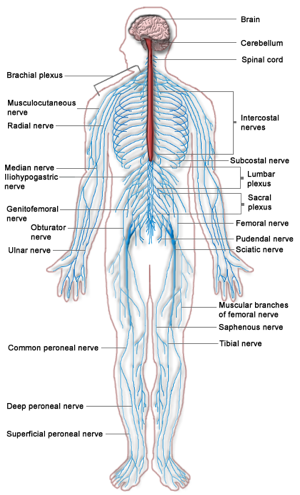
The Nervous System
last authored: Sept 2009, Dave LaPierre
Introduction
The nervous system is the control and processing system of the body, likely representing the most complicated structures in the universe. The central nervous system (CNS) is composed of the brain and spinal cord, while the peripheral nervous system contains nerves carrying signals to and from the CNS.

used with permission
Components
The brain and spinal cord are the site of processing, integration, and output of the nervious system. From them come nerves (general info), including cranial nerves and spinal nerves.
The CNS and nerves are composed of cells called neurons which are arranged into neural circuits. Signals are propogated via action potentials and between neurons via neurotransmitters. The support cells of the nervous system are called glial cells.
Function of the Nervous System
The brain holds the mind and being, though opinions on their specific relationship vary widely.
The autonomic nervous system controls involuntary, homeostatic functions such as heart rate and digestion. The sympathetic nervous system and parasympathetic nervous system are the two opposing forces of the ANS.
The somatic nervous system includes the motor system and the sensory systems.
Additional Resources
- Sylvius.com - Neuronanatomy visual glossary
- Temple University School of Medicine Neuroanatomy Lab
- McGill - the Brain from Top to Bottom
